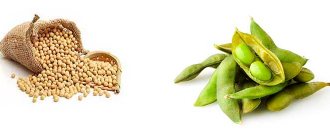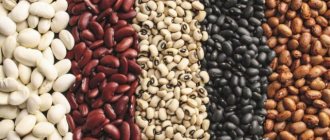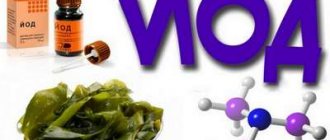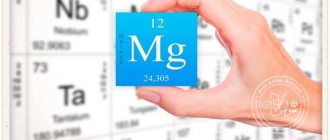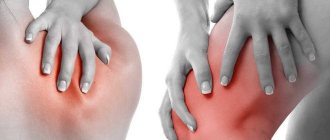Hello to all sports nutrition fans! Guys and girls who just come to the gym suddenly begin to take care of their health: eat vegetables, drink still water, refuse GMO products for completely far-fetched reasons. Of course, when they hear the phrase “creatine monohydrate”, thoughts about steroids, chemistry and everything else immediately pop up in their heads.
A comedian once said: “Everyone loves organics and is afraid of chemistry. And this despite the fact that organic is crocodiles and feces, and chemical... well... everything is chemical!
In this article, we will examine common myths about this supplement and tell you why it should neither be feared nor overly extolled. Go!
What is creatine?
Creatine is an amino acid that is produced by our body, namely the pancreas, kidneys and liver. It is also found in some animal products. In red meat, for example.
Creatine is involved in energy metabolism. In particular, it neutralizes acids that are formed during training and give a feeling of fatigue. Without this component, the effectiveness of training decreases, and muscles quickly deplete.
What are they made of? This is a synthesized product. It is obtained as a result of the chemical reaction of sarcosine and cyanamide. First there is a reaction, then cleaning, then drying and finally grinding.
The effect of creatine on the body's condition
Creatine is contained in muscle structures and is used by humans to carry out energy metabolic processes, physical activity and normalize the ratio of proteins, fats and carbohydrates.
Please note: that nitrogen amine compounds contained in muscle structures are used by the body as a reservoir of energy source, containing up to 140 grams of this substance, despite the fact that on average a person consumes about 2 grams per day.
But, with heavy physical activity and sports training, creatine consumption increases. Inside the human body, nitrogen amine compounds interact with phosphates, resulting in the formation of phosphocreatines, which help improve metabolic processes in the cavity of muscle tissue. The natural processes of creatine restoration in humans proceed at a rather slow speed, and it may take up to 2 weeks for the normal concentration of carboxylic acid to be restored.
Video
The functional feature of nitrogen amine is hardly noticeable in everyday life, but with increased physical activity, the amine helps:
- endure the pain;
- overcome feelings of physical discomfort;
- feel a surge of strength;
- strengthen tendon areas and almost all joints;
- balance the performance of the nervous and cardiovascular systems.
In humans, the synthesis of this acid is carried out by the kidneys, pancreas and liver, but this requires the supply of amino acids in the form of: glycine, arginine and methionine.
How does he work?
During cellular activity, energy in the muscles comes from adenosine triphosphate (ATP) molecules. Its reserves are very limited - they are enough for literally a few seconds of muscle activity. Therefore, it is synthesized constantly.
It is for the synthesis of ATP that creatine phosphorus is needed. It is clear that it is not infinite either. The reserve is exhausted after about two minutes of intense exercise.
Note! You feel it every workout when you can't lift the barbell at the end of a set at least one more time.
Nutritional supplements with creatine can provide the necessary nutrition to muscle cells. It is quickly absorbed and reaches the muscles. There it miraculously turns into creatine phosphorate, which we talked about above.
Why is creatine so popular?
Because it's effective. The positive effect of using creatine is observed in most athletes. The effectiveness range of creatine is about 60-80%. People for whom creatine does not work individually have low sensitivity to this substance.
To make it easier to understand the effects of creatine, I explain where muscles have energy.
ATP - energy in muscles
ATP (adenosine triphosphate) is a compound found in muscles that is the body's universal carrier of cellular energy. ATP was discovered in 1939 by the German chemist K. Lohmann. And for the discovery of the function of ATP as a universal energy carrier, Lipmann received the Nobel Prize in 1953. ATP is the most important factor responsible for the functioning of muscle cells. To obtain ATP, the body must receive food and drink, that is, carbohydrates, proteins and fats. Food is converted into ATP through a biochemical reaction.
Mechanics of muscle action - energy changes
Energy in cells is released when a high energy bond is broken and one phosphate moiety breaks away from the ATP molecule and leaves adenosine diphosphate (ADP). This released energy is used to power the muscles. Adenosine triphosphate consumes numerous enzymes, the energy stored in this compound is used to carry out processes such as: cell regeneration, cell division and biosynthesis. ATP is created on an ongoing basis by the body and consumed.
What foods contain creatine?
When I explain to clients that creatine can be consumed not only in powder, but also in food, they calm down a little. Here is a list of foods that contain creatine. The calculation is indicated in grams per 1 kg of product.
- Salmon – 4.5.
- Beef – 4.4.
- Tuna – 4.
- Herring – 10.
- Pork – 5.
- Milk – 0.1.
- Cod – 0.1.
- Cranberry – 0.02.
It should be noted that in cooked foods the amount of creatine decreases. Yes, this also applies to meat. No, this does not mean that it should be eaten raw.
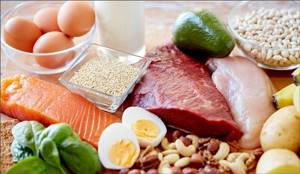
If you no longer want to consume nutritional supplements, add these products to your diet. Remember that without consuming vitamins and microelements it is very difficult to build muscles.
Composition and types of creatine
Creatine can be sold in different forms:
- Monohydrite - the substance enters the body along with sugar (taken about 5g per day).
- Tri-Creatine Malate is malic acid combined with creatine. This combination increases efficiency.
- Ethyl ether – sold in capsule, powder or tablet form. Absorbed without sugar.
- Kre-Alkaly is a buffer substance that is not creatine, but is converted into it in the body.
- Micronized creatine - the supplement is better absorbed as it consists of tiny particles. Consumed with water.
- Conjugate – creatine concentrate. Consumed in minimal doses - a quarter of a teaspoon per day.
The types tested are listed above. For some time, “liquid creatine” could be found on the sporting goods market. It immediately lost popularity due to its unstable action and severe side effects.
How does creatine affect metabolism?
Creatine in the form of phosphocreatine plays a key role in the production of ATP as the main source of energy for muscle function. This is best seen in strength sports: bodybuilding, CrossFit and athletics. When the brain sends a signal to the muscles and follows the contraction of ATP, it breaks down into ADP and energy is released from the muscles. If the contraction is repeated, the process of restoration of the phosphate residue occurs - that is, the reconstruction of ATP with ADP. This allows continuity of energy production to be maintained.
During intense strength or speed training, ATP synthesis does not keep pace with energy production. As a result of high intensity efforts, the level of ATP in the muscles decreases - that is, fatigue. The strength and duration of muscle contraction decreases.
If an athlete takes supplemental creatine, it increases the body's phosphocreatine stores. This allows you to synthesize ATP faster, increases strength and endurance (resistance to fatigue). The muscles adapt better to the load, and their condition allows for more intense training. Results are achieved much faster.
The benefits and harms of creatine
Now you understand how creatine and creatine phosphate work. Let's try to figure out what its benefits and harms are for training and the body. Let's start with the positive effects:
- Muscle strength increases. The maximum weight you lift will immediately increase by up to 10%. Check;
- Increased endurance. The workout will actually last longer.
- Muscle mass builds faster. More weight means more load, more endurance means more load in general.
- Increase in “dry” weight. Muscle mass grows without the need to burn calories from protein-rich foods.
- Fast recovery after training. After a few hours, you'll feel like you just took a walk in the park.
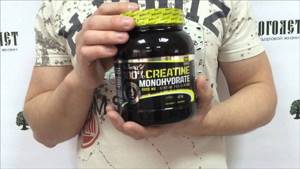
Now about the disadvantages. Creatine itself is not dangerous to your health, but failure to follow the recommended intake may increase the likelihood of side effects:
- Water retention.
- Cramps.
- Dehydration.
- Digestive disorders.
- Etc.
Side effects occur in 4% of cases and are not irreversible. We will talk about them in more detail below.
Harmfulness of the supplement
To begin with, it’s worth determining for yourself exactly why you should take these supplements and whether it’s worth it. After all, it is not recommended to use them just like that. For an ordinary person, the concentration of carboxylic acid that comes with food is enough. But, if taking nitrogen amines in the form of specialized additives is necessary, then you should know why this component is harmful and what side reactions the carboxylic acid can cause.
The effect of creatine on health
Most often, if a nutritional supplement is used incorrectly, or if you take an expired product, the following side effects may occur:
- fluid retention in the body cavity, but without the formation of swelling. When you stop taking the drug, a slight weight loss is observed, so an increase in fluid concentration is considered normal, since most of it passes into the muscle structures;
- if amines are taken during cutting in bodybuilding, then dehydration may occur; to prevent it during such periods, it is better not to take the supplement and drink as much water as possible;
- if you consume a large amount of dietary supplements of carboxylic acids, this can result in disruption of the digestive processes and the development of diarrhea, cramps and pain in the abdominal area;
- More rare events include acne, pimples, spasms, and cramps, although the relationship between these events and creatine intake has not been clinically confirmed.
It has been established that a sports supplement in the form of pure creatine has no effect on the liver, renal and cardiovascular organ systems.
Impact on male potency
Taking nitrogen amine does not have any effect on reproductive functions in either women or men. The use of even a high dose of creatine supplement will not affect male potency in any way; the main thing is to purchase only high-quality products, since side effects often occur due to the action not of carboxylic acid, but of additional ingredients contained in this product.
Video
Possible contraindications
Creatine dietary supplement is not recommended for use in the following cases:
- with the development of renal failure;
- asthmatics;
- during pregnancy;
- in childhood;
- with the development of diabetes mellitus.
If a minor child leads an active sports lifestyle, then the use of sports supplements is possible with appropriate adjustment of the dose taken.
Side effects of creatine
This food additive cannot cause serious harm to health. Safety is also confirmed by experiments in which people were given unimaginably large doses of creatine - up to 30g. Nothing irreversible has happened, but there are side effects.
- Water retention.
The effect of creatine is associated with water retention in the body. Roughly speaking, it saturates your muscles with fluid. You can notice this only by weight. You will not experience swelling or other visual changes.
After discontinuation of the drug, excess fluid is removed. Due to this, you will lose about 20% of the gained weight.
Note! Do not try to take a diuretic or limit your water intake to avoid delays. This way you will absolutely get dehydrated.
- Dehydration.
The problem is directly related to water retention. Creatine moves fluid from the blood into the muscles, leading the body to dehydration. This leads to disturbances in thermoregulation and metabolism.
To replenish your “reserves” you need to drink a lot of water. Approximately 3 liters per day. Rehydration will allow you to normalize your body and prevent other side effects.
- Cramps.
Scientists deny a direct connection between creatine and seizures. Tests on athletes did not show any alarming results. Cramps and spasms can only appear as a result of dehydration or a sharp increase in muscle mass. In the latter case they will pass, don't worry.

- Skin problems.
Yes, some people get acne and pimples. This is due to increased testosterone production. There is nowhere to go. Comfort yourself with the fact that the acne will go away, but the accumulated mass will remain. Well, 80 percent of it. Don't forget about water in your muscles =)
- Allergic reactions.
Occurs most often in asthmatics. Manifest in the form of itching, redness and peeling of the skin. In exceptional cases - at elevated temperatures.
If you have a reaction, take the creatine pack to your nearest allergist. Most likely, the supplement contains another allergen (not creatine). Get tested and choose another product.
Creatine abuse
An overdose of the drug has not been detected experimentally. The human body does not react in any way even to 30 grams consumed at a time.
Note! This doesn't mean you need to eat 30 grams of the substance in one sitting. The excess is eliminated from the body naturally. You won't get any additional benefits other than creatine-laden waste products.
Expert opinion
Smirnov Viktor Petrovich Dietitian, Samara
Creatine is indeed an important source of energy, but if it is used incorrectly and abused with special sports nutrition supplements, it can do more harm than good. If a novice bodybuilder has undergone a full medical examination and it turns out that he does not have any kidney pathology, then he can use this compound to intensify his training and to feel cheerful and energetic. But such use of creatine cannot be permanent. It is advisable to use it no more than once a week, since this type of increase in the body’s endurance is artificial. In addition, do not confuse creatine with creatinine. Creatinine is a product of the breakdown of muscle tissue and is excreted by the kidneys. Creatinine can be considered the end product of the breakdown of muscle tissue, including creatine. It accumulates in the blood of patients with chronic kidney disease. If a novice bodybuilder has chronic kidney diseases, for example, pyelonephritis or glomerulonephritis, then before purchasing any sports nutrition, you need to consult a doctor.
How to take creatine correctly?
Oh, the concentration of keratin in the supplement differs for each manufacturer. The composition sometimes contains other amino acids and fast carbohydrates. It is best to follow the recommendations on the packaging. If you bought monohydrate, but could not find any recommendations on how to drink it, here is a rough description of the course:
- Take 5 to 6 grams per day.
- On training days, take the substance after training along with a protein shake, amino acids or mass gainer.
- On non-training days (rest days), take the supplement in the morning with a glass of sweet juice.
The course lasts 2 months. After this you need to take a break of 3-4 weeks. Then you can resume taking it again. And so on in a circle.
Taking the “loading phase” suggests taking 5 grams of the substance 4 times a day between meals, reducing the dose to 2 grams and 1 time per day on the 6-7th day of the course.
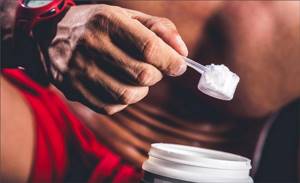
The course “with loading” lasts one month and is repeated after 3-4 weeks.
Note! Drinking coffee, alcohol and diuretics during the course is not recommended. They increase the risk of side effects.
Where is it contained?
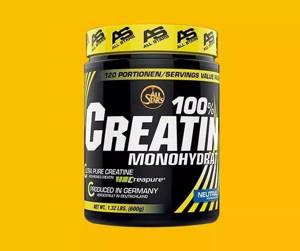
To improve physical activity, increase overall endurance and strength, the human body needs to receive a sufficient amount of creatine. With regular strength training, an athlete needs from 1 to 5 grams of this substance per day. The specific dosage is calculated individually and depends on the weight category and sports goals.
Myths about creatine
They said so much about creatine: it causes impotence, is an anabolic, leads to kidney problems, insomnia and even depression. Of course not.
The experiments did NOT reveal any patterns between creatine intake and:
- High blood pressure.
- Diseases of the cardiovascular system.
- Weakening of male potency.
- Infertility.
- Etc.
The list goes on and on. The harm is limited to the side effects that we wrote about above.

Also, the supplement is not a steroid and is even sold in a pharmacy, but for anabolic steroids you will have to go to the black market. And, of course, it does not cause any addiction. “Think about it,” as they say.
TOP 5 best creatines
The list was compiled using expert and user assessments:
5. Micronized Creatine. Developed by the sports nutrition brand Dymatize. Available in packages of 500 grams, it costs approximately 600 rubles. Included in the list of best-selling creatines. The price is good, as is the availability of international standard certification;
4. Micronized Creatine Powder . Optimum Nutrition brand. The absence of any doping impurities and exceptional digestibility by the body. Price – 1000 rubles per 600 grams.
3. HEMO-RAGE Black. The seller is Nutrex. In addition to muscle strength and endurance, it increases the athlete’s concentration. Very effective. We warn you, the price is steep - 2000 rubles. for 292 grams. Many people are intolerant to the supplement.
2. Creatine Monohydrate. Developed by Ultimate Nutrition the best price/quality combination on the market. Colossal performance at a price of 1500 rubles. per 1000 grams.
1. NO-XPLODE CREATINE. Our favorite is BSN. Everything is on point here: good digestibility, high efficiency and, what’s very cool, improvement in the cognitive functions of the brain. The product has been approved by Rospotrebnadzor, the balance of active substances is perfect. Price – 1900 rub. per 1000 grams.
Why is creatine needed in bodybuilding?
Supplementing with creatine for bodybuilding provides the following benefits:
1 Increases the duration of short-term high-intensity exercises
The more creatine accumulated in muscles, the more energy molecules ATP 3 can be created from it.
Taking creatine as a sports nutrition supplement can help increase muscle concentrations in most athletes, but not all (see How to Take Creatine for an explanation).
2 The body recovers faster between sets
The rate at which new energy ATP molecules are created between sets increases.
Many sports consist of phases of high-intensity exercise and varying recovery times. The concentration of creatine in the muscles determines the rate of creation of new ATP molecules and, accordingly, the readiness to perform the next intense phase.
If you think what we do is important, support our project!
YES!
3 The moment of onset of feeling tired is delayed
The ability of cells to store energy improves.
Creatine increases the cell's ability to retain ions of certain substances that are involved in the synthesis of energy 7. This leads to a delay in the moment when a feeling of fatigue appears, and the duration of the active phase increases.
All the effects taken together—increasing the time it takes to complete an approach, delaying the feeling of fatigue, accelerating recovery—increase the effectiveness of the workout and allow you to train with larger weights, which creates a stimulus for muscle growth.
Important: According to research, taking creatine is ONLY beneficial when performing intense short-term exercise , such as weight lifting in bodybuilding or sprinting: it does lead to increased muscle strength and endurance.
Taking creatine helps increase muscle strength, mass and endurance, but only during short-term and intense exercise
We recommend : How to take protein for muscle growth?
Reviews about creatine
The reviews are clear. Everyone who has tried it notes increased endurance and muscle growth. I don’t fully understand the guys who buy it for aerobics (after all, aerobics is more about losing weight, and creatine is about muscle growth), but even those without exception note an increase in the effectiveness of their training.
What do scientists say?
The harmlessness of creatine supplements for the human body has been scientifically proven by many studies. No serious disorders were identified even with extremely large doses (30 grams at a time). The increase in muscle mass and strength is obvious and confirmed.
A few words about the effectiveness of creatine
Creatine is one of the few supplements whose effectiveness has been scientifically proven. Among the main effects of taking creatine are an increase in lean muscle mass, strength, and even the secretion of key anabolic hormones.
Today, creatine is one of the most popular sports supplements ; almost every reputable sports nutrition brand has a whole line of creatine-based products in its portfolio.
conclusions
Let's summarize. Don't be afraid of creatine. This is a great supplement, especially for strength training. It does not pose a risk to human health, is sold legally and acts quickly.
Exceeding the daily dosage will not bring you any effect. Neither positive nor negative. Excess substances will simply leave the body along with urine. Possible side effects.
You can ask me a question via feedback. I will be happy to answer! Follow the recommendations, watch your body and drink more water during your creatine cycle. Don't forget to share this article with your friends!
